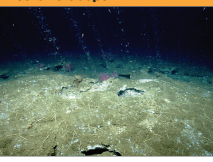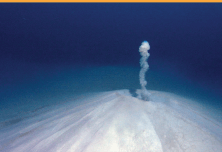
The cold seep is an area of the ocean where gases escape from cracks and fissures. This happens on the ocean floor. The cold term used here doesn’t refer to the actual coldness of the water but to make a difference from heated organic material released from hydrothermal vents.
Types Of Cold Seeps:
- Methane Seeps: Methane and hydrogen are released from the seafloor, and digested then by microbes.

- Brine Seeps Or Brine Pools: Beneath the ocean floor, seawater slowly permeates through dense salt layers, dissolving them along its path. This highly saline water, denser than the surrounding seawater, gradually settles at the seabed, creating mesmerizing underwater pools.

- Mud Volcanoes: When much-saturated water is in the seafloor, the gas pushes the mud up to the surface.

- Oil Seeps: Organic gas escapes from the seafloor, it could be thick and sticky or dark and fluid.

The Formation Process:
The cold seep itself is formed due to the earth’s crust activity, specifically the tectonic activity. Methane and oil seep from those figures diffused by sediment and emerge to a hundred meters wide in the water by currents.
Scientists thought they existed for thousands of years. Depth range starting from 200 meters.Cold Seeps form when there is so much organic material released from the seafloor due to the pressure of the tectonic plate squeezing the sediments below.
Methane (CH4) is the basic component of cold seeps. The deepest cold seeps have greater specialization than those in shelf depths. This place is the place with the most geochemical and microbial processes.

Comparaison With Other Chmosynthesis Communities:
The cold seeps alongside hydrothermal vents rely on chemosynthesis for energy production. The primary organism to benefit from this deep-sea ecosystem is bacteria. This bacteria can metabolize methane and hydrogen sulfide.
They both have the presence of chemical compounds like (H2S and hydrocarbonates), local hypoxia, or even anoxia. But they differ in many ways, vents are more vulnerable in high temperatures of organic material, sulfide, and oxygen concentrations, often in the absence of sediments. Cold sleeps have more slow rate, with cooler temperatures and stability. Plus, the organisms living by cold sleep have a much higher lifespan than those by hydrothermal vents.


Why Cold Seeps Are Important:
They have unique typography over time. Chemical reaction is also dependent on bacterial activity. To understand, the significant importance of this specific environment, considering that:
A Habitat:
They provide a habitat for many creatures living in those depths, plus a nursing and breeding ground for successful reproduction.
Natural Ressources Value:
Studies and discoveries of cold seeps help to understand renewable energy resources like hydrocarbon. Plus, this helps scientists discover more about weather, tides, and currents and how they are affecting oil movement.
A Nature Transporter:
Cold Seeps are natural transporter in the ocean from the seafloor, moving organic material to bacteria and the living species arrond.
Technologies Used to Study Cold Seep Environments:
Highly designed rov are designed to go to such great depths(exceeding 200 meters from the surface), and then when arriving, an arm of the remotely operated vehicles is extended to dig in the sandy cold seeps surface and extract a sample for scientists to study.
Cold Seep Environmental Impacts And Threats:
This part of the ocean faces many threats like climate change, litter and garbage thrown by humans can overlay the sediment resulting in much more gas exchange and interfering with other organisms on the bottom of the sea. Weapons and war bombs also affect cold sleep. Plus, the lost fishing gear can damage this environment.
Another threat is the transportation of energy from surface waters to the seafloor. The production will change from surface layers down to the seafloor affecting the quantity and quality of the organic matter.
Did You Know that tube worms are the most dominant living species in the cold seep environment?

As we conclude our exploration of the captivating world of cold seeps, it becomes evident that these enigmatic environments hold a wealth of secrets waiting to be unveiled. At DeepSeaWonders.net, we have delved into the depths of the ocean to shed light on the fascinating geological, chemical, and biological processes that define cold seep ecosystems.
Other Ocean Habitats:
The Life In The Sandy Seafloor
What Animals Live In Coral Reefs
